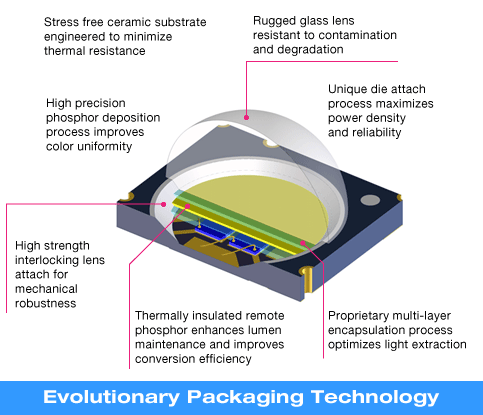How to extend the life of high brightness LED
Time:2015-10-10 Views:4002 Compile:SUNPER
It is very clear that the long life as well as durability characteristics of the light emitting diode comes in handy with different applications thereby bringing some obvious benefits. However, when the high power LED for high luminosity operation, the heat has become one of the major key issues. In fact, the input power of the LEDs is less than 50 percent in light form while the remaining 50 percent is usually converted into heat. Thus, this is a major issue that all the lighting system designers should overcome. This will help greatly in improving the life of the high brightness LED. There are many tips to help you extend the life of the LEDs and here are some of them.

If there is poor implementation of the lighting system, it will be very difficult to develop their potential even for the most perfect thermal design. Maintaining the LEDs so that they will always be safe when in operation is important. One of the ways to achieve this is by reduction of the heat dissipated as it may affect the lifetime of the LEDs product. The responsibility normally falls on the top for the driving LED electronic components. In fact, when looking at high luminosity LED components and manufacturer specifications, it is a bit easier to determine the main design parameters needed. However, you should be keen for your LEDs not to operate under high temperatures since this may have a negative effect on your devices.
The real temperature and life power dissipation as well as the LED junction it mostly inversely proportional. The manufacturers may display the running for about 100 million hours average time between failures at temperatures of Tj80 temperature. In any practical system, the failure of the LEDs may not actually cause big problems. However, in lack of heat, the Tj may rise to 120 or even above and hence this will significantly reduce the LED lifetime. If the LEDs are used under extreme cases, the LED life will reduce before the actual time.

A proper thermal design can also be introduced in order to contend with all the kinds of environment be it harsh or favorable. Anyway, this is not always impossible with all cases. An example is that in down-lights, LEDs are usually installed in the ceiling in the space between the insulating layer. Installation of any additional cooling facilities may not be possible since the available space is less. The relative luminosity may also vary inversely with the junction temperature. The best thing is that with proper variation of data, the manufacturers can estimate the light output at the maximum and thus the junction temperature may decrease by 30 percent.
Similarly, the lumen maintenance effect is also inversely proportional to the junction temperature. At the junction temperature of 70, the LED operating more than 50,000 hours usually leads to light output loss of 3 percent. Higher temperatures causes greater loses although the official data is yet to be made publicly. Therefore, the designer of the most crucial goal is to distribute the heat as soon as possible. Consequently, this will lead to better maintenance at the maximum junction temperature as well as no premature failure.
Generally, in order to get the desired LED current generation of the electronic devices that may detect the temperature needed to effectively reduce this issue, there should be LED drive current to help maintain a stable operating temperature. Anyway, the LEDs vitality is very string and thus it can operate for a long time despite the light output being slightly reduced.
An example is that the buck converter of the LED driver circuit design is equipped with a temperature control function and a drive current of up to 1 amp and voltage supply of about 4 to 6 volts. The circuit uses 150KNTC thermistor temperature detection thereby establishing an assembly position as well as proper LED maintenance. The control manager currents flowing through the heat is doubled and then added to the peak switching current in order to regulate the LED current.
In order to be sure that your valuable high luminosity are well protected, you only need to add a simple as well as low cost effective electronic components. This thermal protection design assists in the lighting system designers. This leads to proper implementation and lower cost of production. This ensures that everyone can effectively afford LED products.
More Posts
█ Main Factors That Determine the lifespan of LED Lightings
The Hazard of inferior LED lighting products
Next:Four main advantages of the LED Floodlights explained
User comments
Your current input 0 characters(Reply for at least 6 characters)。
Online Services

Mobile: +86 18938902515 (Mr.Allen)
Tel:+86 755 23159099
Fax:+86 755 61673151
E-mail: sales@sunper.net
zip code: 518108











